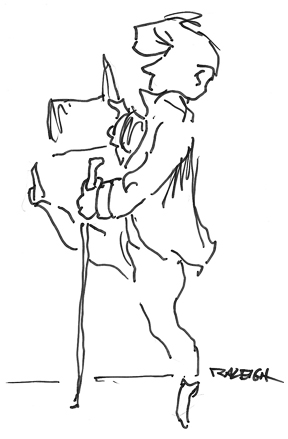Film: Gone But Not (Sigh) Forgotten
By Henry P. Raleigh
arttimes online August 1, 2016
 |
There it was — a full — page ad for a new musical stage production of American Psycho, proclaimed as “a carnal carnival of song and dance.” After a successful London run, it’s based on The Bret Easton Ellis’s novel about a yuppie killer as was the 2000 movie — non — musical. Carefree slaughter set to music may seem bizarre yet it’s a sure bet a filmed musical version is soon to come.
It must be admitted that it takes a deal of creative talent to portray violence in catchy tunes and appropriate choreography. “Sweeney Todd — Demon Barber of Fleet Street” managed, with the help of Johnny Depp, to fit throat slitting into toe — tapping rhythms. “Chicago” in 2002 taught us how murder was not only fun to sing about but was a dandy career opportunity as well — Catherine Zeta — Jones’ dancing made it all the more enjoyable. Well we’ve come a long way from that first ever musical in 1929 when a bunch of really swell kids deservedly made it big in “Broadway Melody” and introduced a few enduring plot clichés —you know, the chorus gang puts out a smash show despite obstacles, an unknown amateur becomes an overnight star — despite obstacles. Who can forget the desperately enthusiastic, albeit somewhat clumsy, tap numbers of Ruby Keeler in the 1933 “42 Street”. Eleanor Powell in the 1936 “Broadway Melody” thoughtfully showed what tap dancing was all about. Plots hardly existed, if at all, for these 30‘s movies. Mistaken identity, innocent misunderstanding was sufficient to move along the musical numbers. Art Deco ambience was total, nothing of the real world, its grittiness, its social ills never intruded to mar this shiny, squeaky clean black and white make-believe, all of its inhabitants, smartly dressed, were seemingly, inexplicably wealthy, funny, charming, witty. First teamed in the 1933 “Flying Down to Rio” Fred Astaire and Ginger Rogers had been second billed to the romantic leads of Dolores del Rio and Gene Raymond but soon became headliners in “The Gay Divorcee” in ’34, again in the ’35 “Top Hat.”
Often referred to as the golden age of the musical the 50’s saw the full flowering of the genre. Beginning with the 1948 “Easter Parade” all now would be filmed in color blessed with memorable love ballads as They Can’t Take That Away From Me from “The Barkleys of Broadway” in ’49, Dancing In The Dark from “Band Wagon” in ’53. For many critics today, the 1952 “Singing In The Rain” is yet rated the greatest musical of all time. The weightless grace of Fred Astaire gave way to the muscular, athletic routines of Gene Kelly as the musicals themselves did. Gordon MacRae and Shirley Jones replaced Astaire and Rogers — “Oklahoma” ’55, “Carousel” ’56; MacRae with Doris Day in “On Moonlight Bay” in ’51, “By The Light of The Silvery Moon” ’53. As production costs rose fewer original musicals were attempted. Hit stage productions became the main source of movie musicals. “Bye Bye Birdie” ’63 as “Carmen Jones” in ’54, “South Pacific” in ’58 and the previously mentioned “Oklahoma” and “Carousel”. The old musicals became musical plays espousing moral and social issues: “Jesus Christ Superstar” 1973 born out of a rock opera, coming of age problems in “Fame” 1980, “Rent” 2005 right up to date on AIDS, drugs, sex, and general grunge. Life just isn’t as much fun as in the Roll Out The Barrel days of song and dance. What with all that our current time represents we just don’t have the heart anymore. Or maybe break-dancing and rap just aren’t the moves and sounds that lend themselves to those silly, simple movies of the 30’s. Look, if American Psycho does indeed become a musical can a re-do of The Walking Dead be far behind?
